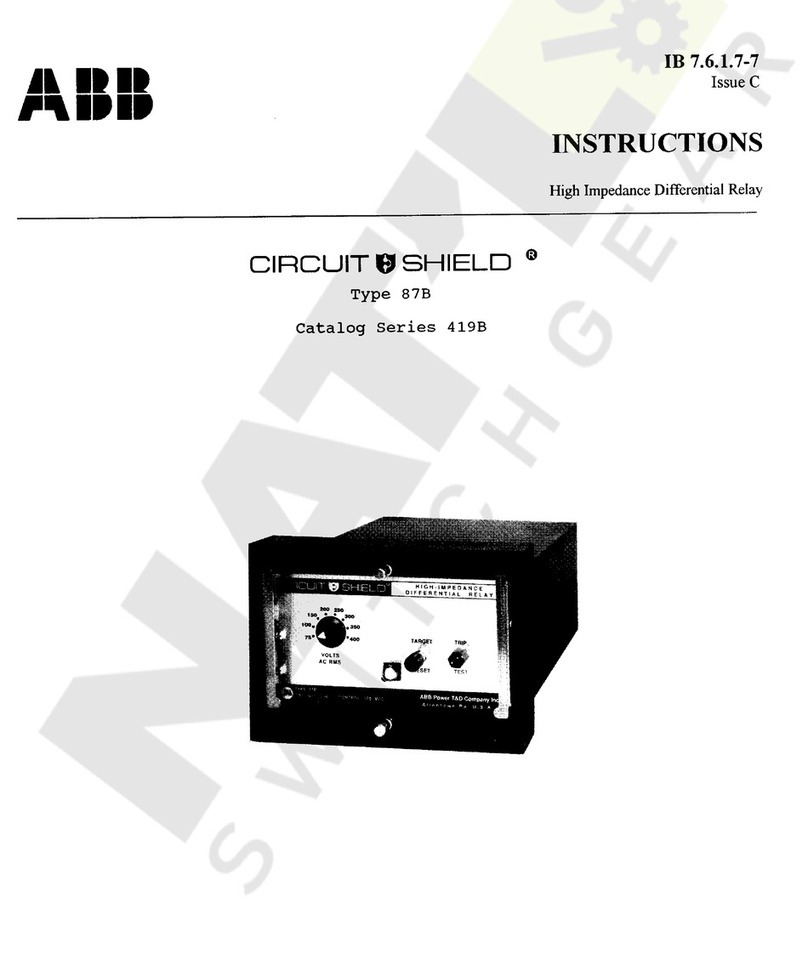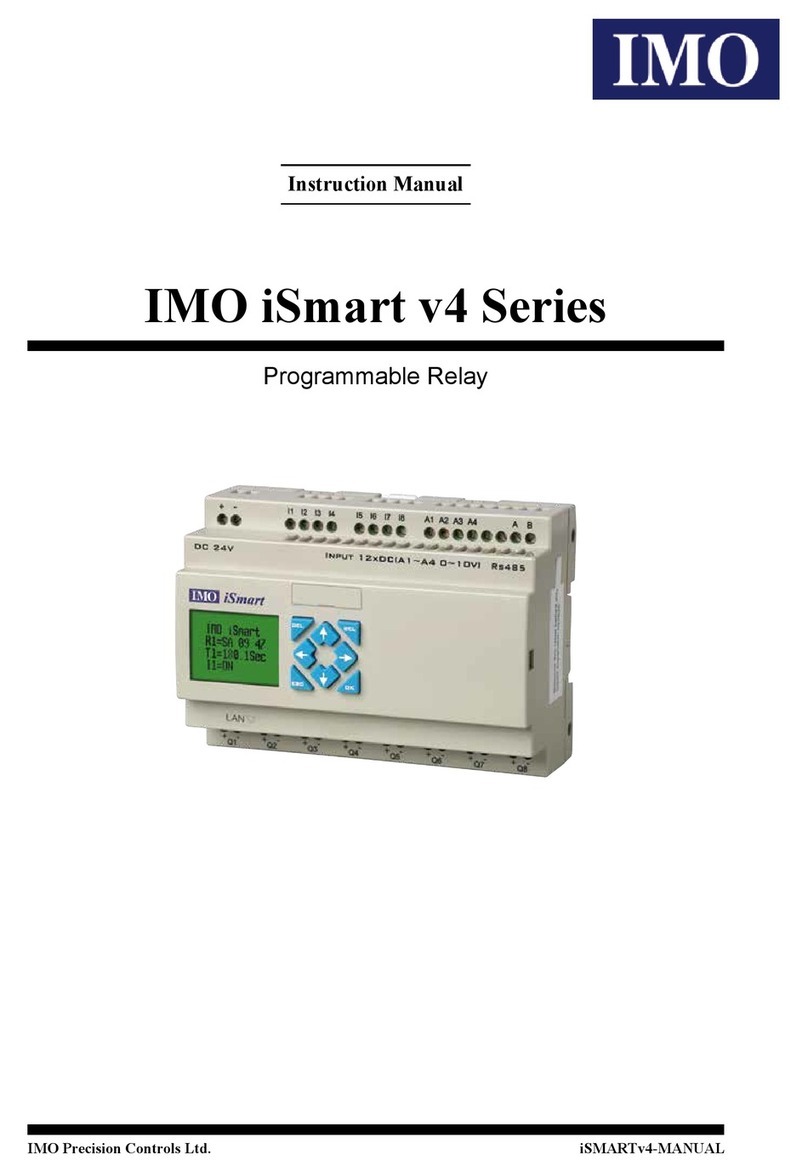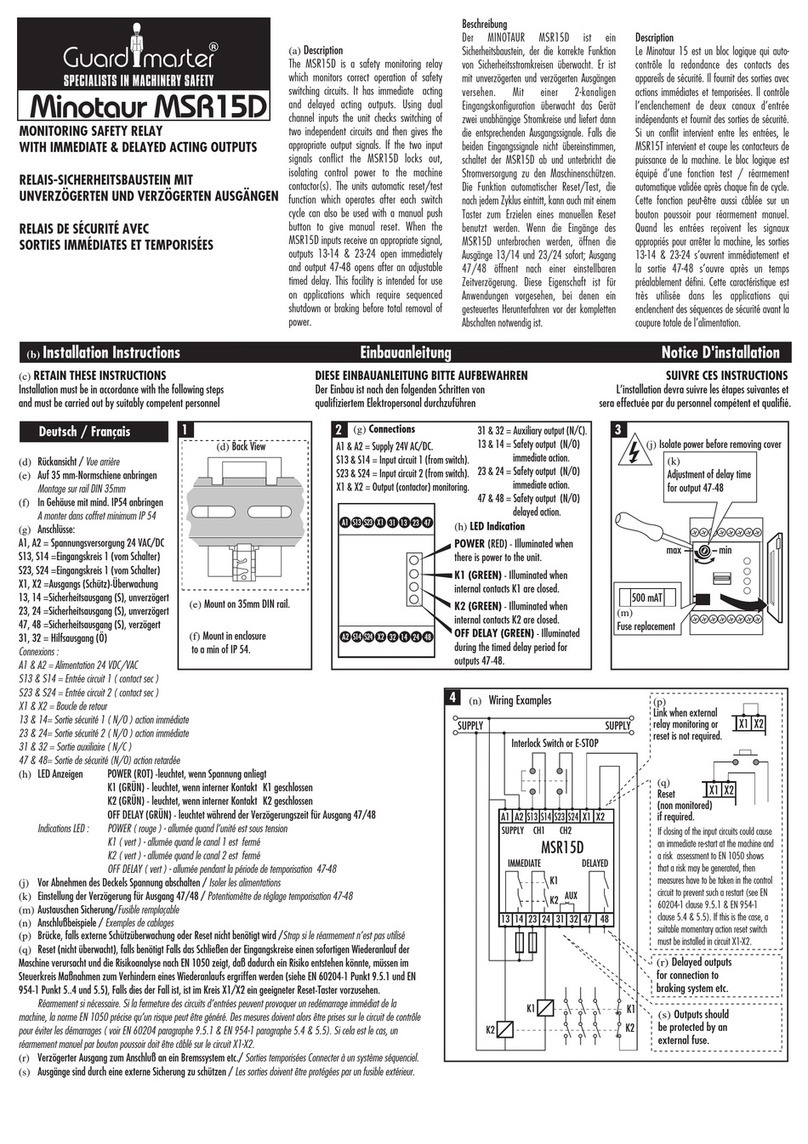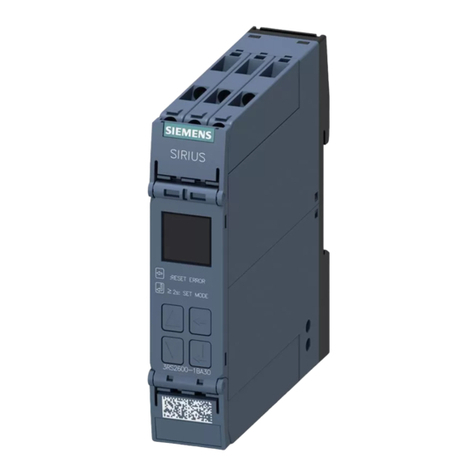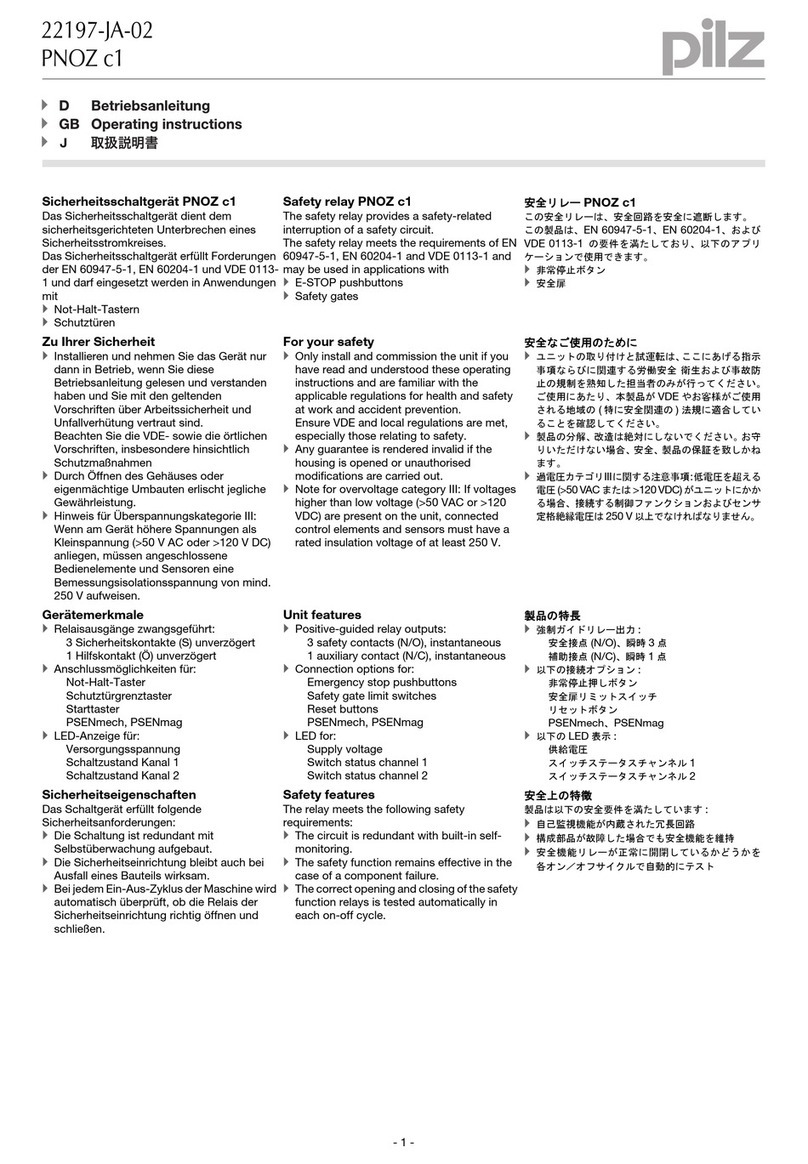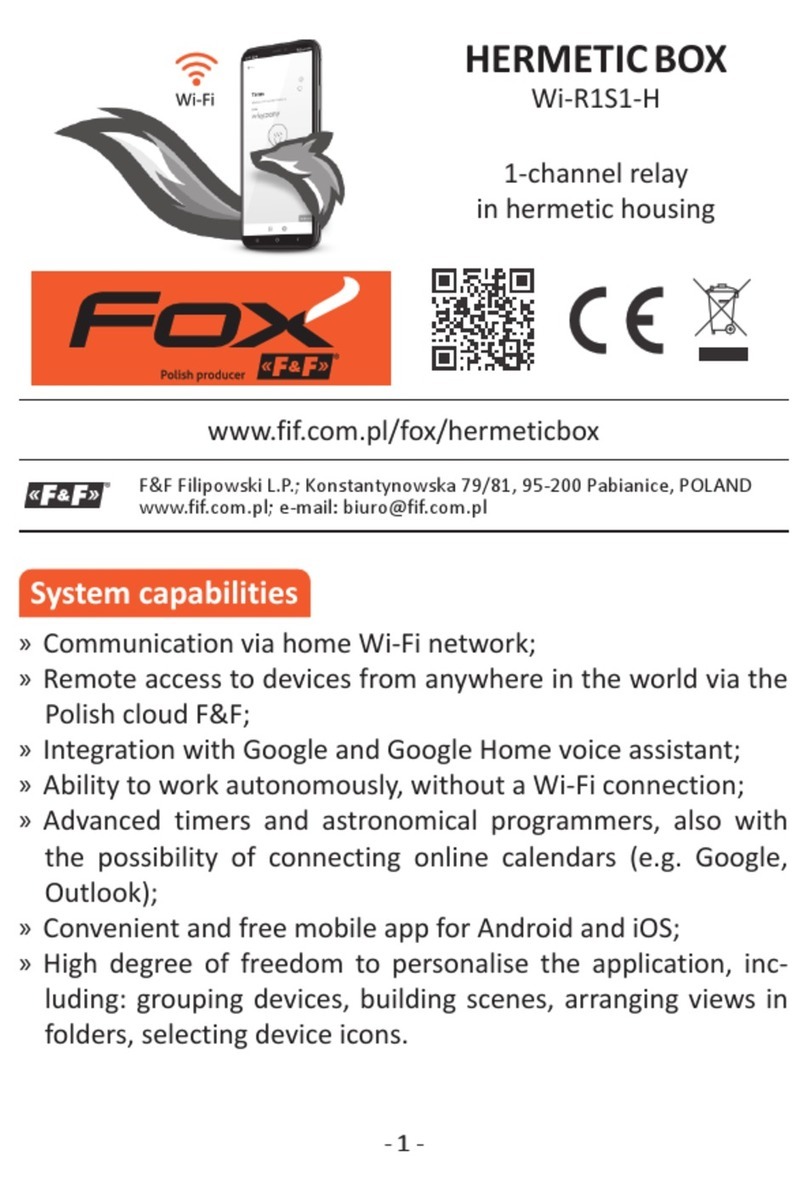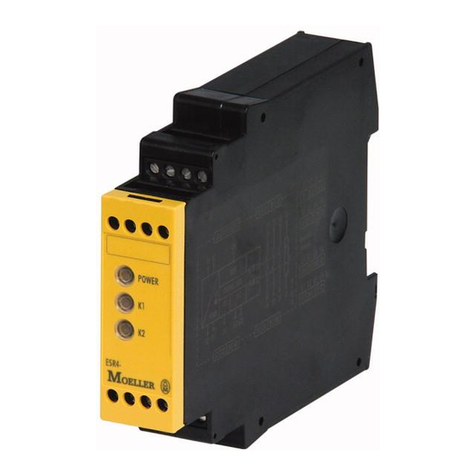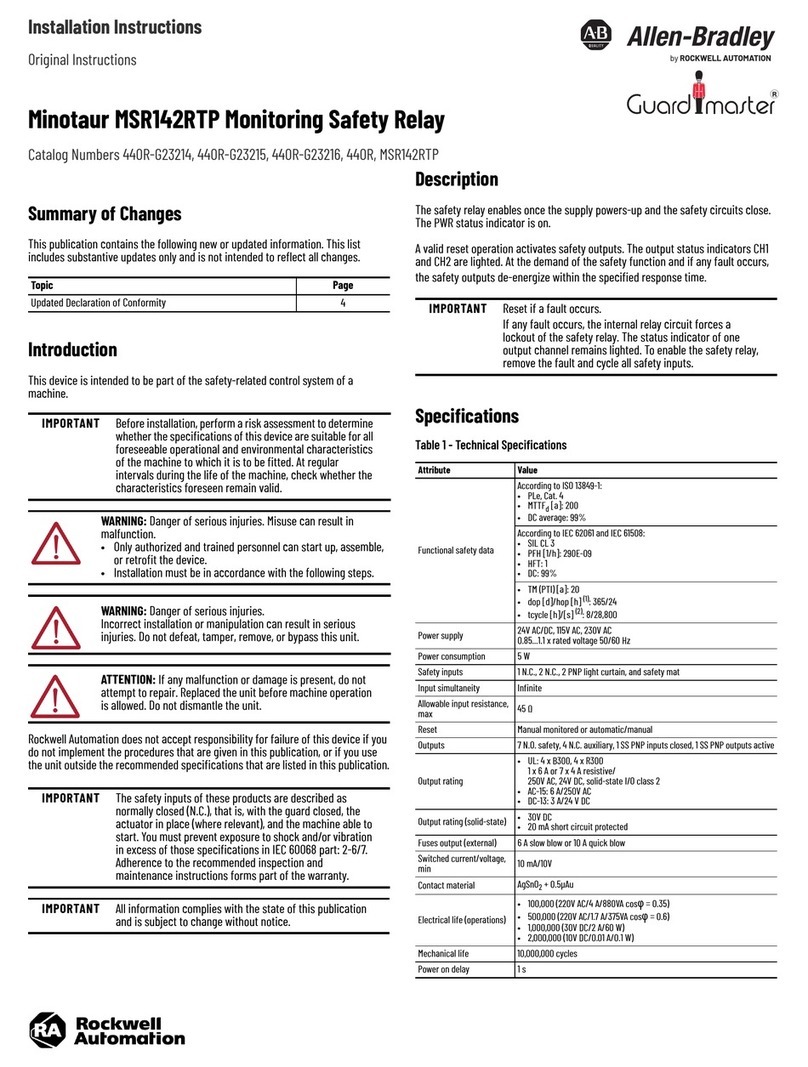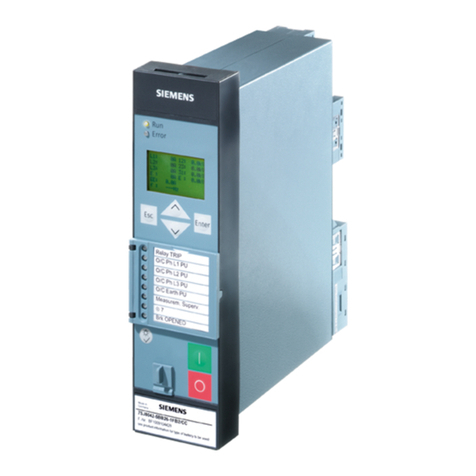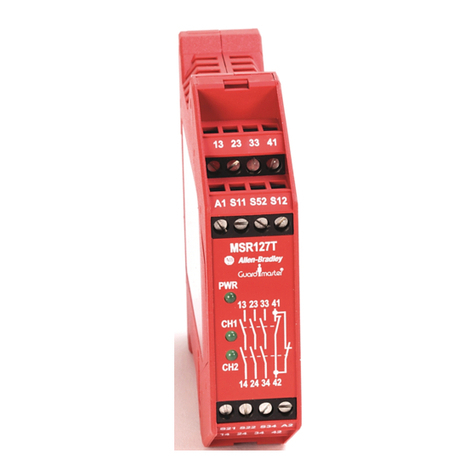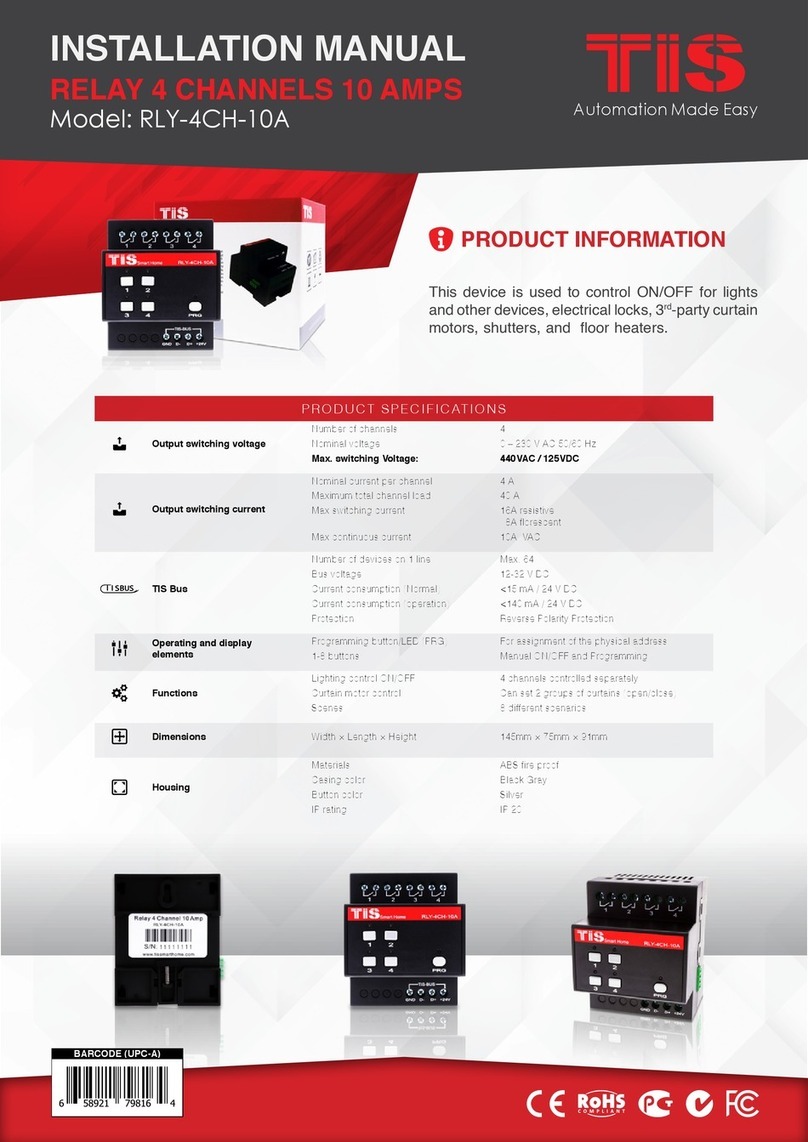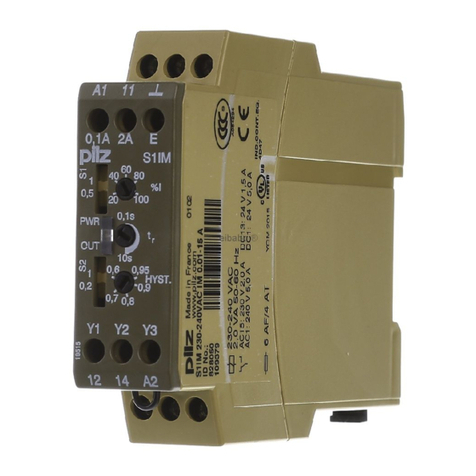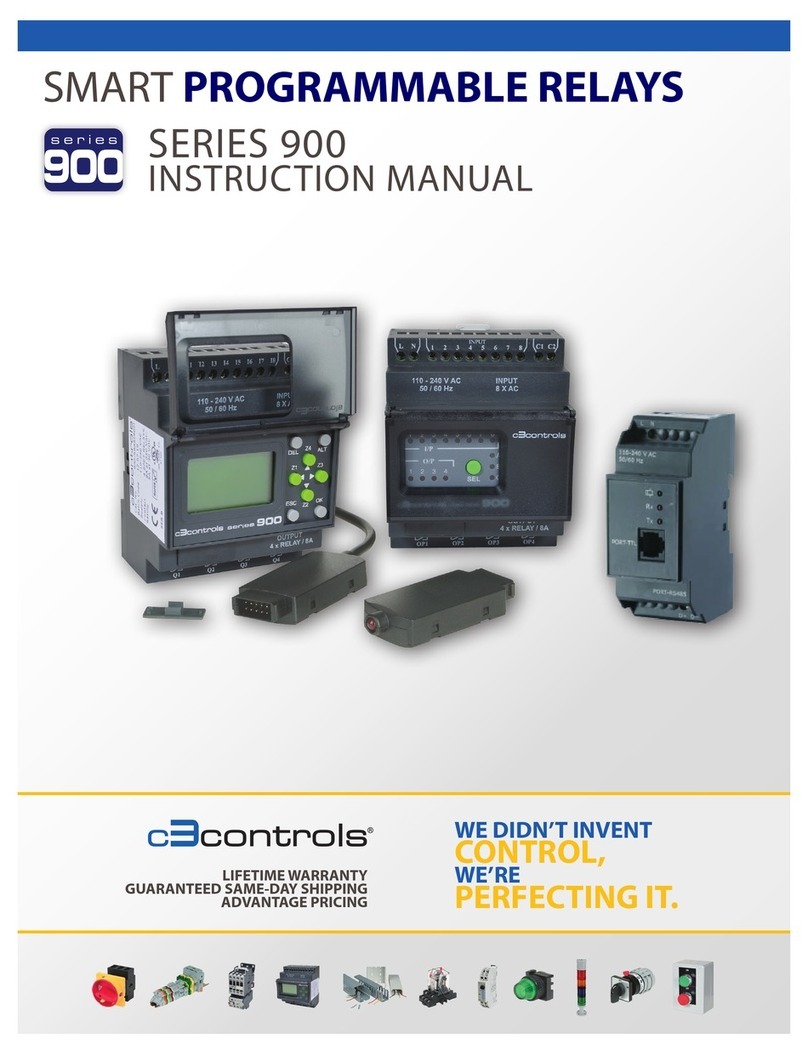Micom ALSTOM P341 Instruction Manual

|AUTOMATION
GRID
MiCOM ALSTOM P341
Interconnection Protection Relay
Software Version: 36 & 71
Hardware Version: J
Technical Data Sheet
P341/EN TDS/F74

Note: The technical manual for this device gives instructions for its installation, commissioning,
and operation. However, the manual cannot cover all conceivable circumstances or
include detailed information on all topics. In the event of questions or specific problems,
do not take any action without proper authorization. Contact the appropriate Alstom Grid
technical sales office and request the necessary information.
Any agreements, commitments, and legal relationships and any obligations on the part of
Alstom Grid including settlements of warranties, result solely from the applicable
purchase contract, which is not affected by the contents of the technical manual.
This device MUST NOT be modified. If any modification is made without the express
permission of Alstom Grid, it will invalidate the warranty, and may render the product
unsafe.
The Alstom Grid logo and any alternative version thereof are trademarks and service marks of Alstom
Grid.
MiCOM is a registered trademark of Alstom Grid. All trade names or trademarks mentioned herein
whether registered or not, are the property of their owners.
This manual is provided for informational use only and is subject to change without notice.
© 2010, Alstom Grid. All rights reserved.

!"#!#
$$!%" #
!!$!#
!!
$!
!
"#$ #"%
##&"
" !" '#%
##
% &
" "& #%(&"
#' "%
)*+#",-
#&""",- %
).
&'(

!""# "
$"%"&
'
"
( "
)*
+
(
"
,
-
+%
,
.)*
+
/
00
123
""
," "
,
+
&
+
123 4%
"
+

!
"
#
$%
#
#&
#
'
!"#
$%&
!
#
($%

!
"!
#
$
##
%
$
#
#
#
&#$#
$
'
(
#)
*$#
+*,+(!+(((
+*,
#
#
$#
#-./
00-)01-1-/2-)33-
1
+
!"#$
3
%&
($
'"$
#
"30
*$
#
$
$
#
"30
$#
($
4)
##
)*'

!
!
"
#!$%$
$&$
"!
'()*
+, &
!
"#
-.*"/,
*/,
"012!
!*!0*0
!
!"3
+4
$%&"'
-.
'"'"
#
#
!!
"
"
++5
.
2-
!12
-
()&
-
'3
"!!
"!!
+""
"
*&)'&
'
!
-.#"!
4
*&)'&&
%
'
-.6'
!
!
'3"
5"
1
*/,
"
!
!
)
"
!
"+
*/,!
" !
!"
*0
!3
"
*0
)
"
'
!!
.
!
!
".
(+(*

!
"
#$%
&'()%*
+
,!,
-
,!,
&).&//-
!,#
.
+
010,2
0
(
1342+
1,2
3
" !
5
6
6
"+!78+8-7
6
"
9
'&$"&)

!!"
#
$!
$
$%
$&'""
()
!!)"*
)
!+"
,)
)
)!
-.
."
)!
!)'"%
)!!
!!
-"%,/,0
.1)!
!-"%
!)
!-
!
"
!!
!"
2!!!
)!!
)!"
$3
$+'
$
$+!'
$3
$+'
$23434%
,
5
!
!!)
"6
)5"
75! !!8!
!"%)
)
!
!!
!!")
!++
)!"
/*(,*9

!"#$%&
'(%%
()
)'
)
'
'')
()
)
!&*
'(
('
)
+,-./
+'
+"0121.3.1&4
+56& 1
+"031
"031'(
"031.
..
'
)
#'.'
)'(&*
#
(' !
(%%
7)'
$8./
$!"!6
)
((( ,,
!9:**12331121
(((
!&*((
!"#$"
*'(' !)
')7;)9
(') <$%!$%
!' !'
$8./%6!) !
'()

P341 Technical Data Sheet 9P341 Software versions 36 & 71J
Technical Data
Mechanical specifications
Design
Modular platform relay, P341 in 40 TE or
60 TE case. Mounting is front of panel flush
mounting, or 19“ rack mounted with rack frame
(ordering options).
Enclosure protection
Per IEC 60529: 1992:
IP 52 Protection (front panel) against dust and
dripping water,
IP 50 Protection for rear and sides of the case,
against dust,
IP 10 Protection Product safety protection for
the rear due to live connections on the terminal
block.
Weight
P341 (40 TE) :7 kg
P341 (60 TE) :9.2 kg
Terminals
AC current and voltage measuring inputs
Located on heavy duty (black) terminal block:
Threaded M4 terminals, for ring lug
connection.
CT inputs have integral safety shorting, on
removal of the terminal block.
General input/output terminals
For power supply, opto inputs, output contacts
and RP1 rear communications.
Located on general purpose (grey) blocks:
Threaded M4 terminals, for ring lug
connection.
Case protective earth connection
Two rear stud connections, threaded M4.
Must be earthed (grounded) for safety,
minimum earth wire size 2.5 mm2.
Front port serial PC interface
EIA(RS)232 DCE, 9 pin D-type female
connector Socket SK1.
Courier protocol for interface to S1 Studio
software.
Isolation to ELV (extra low voltage) level.
Maximum cable length 15 m.
Front download/monitor port
EIA(RS)232, 25 pin D-type female connector
Socket SK2.
For firmware and menu text downloads.
Isolation to ELV level.
Rear communications port (RP1)
EIA(RS)485 signal levels, two wire
connections located on general purpose block,
M4 screw.
For screened twisted pair cable, multidrop,
1000 m max.
For K-Bus, IEC-60870-5-103, MODBUS or
DNP3.0 protocol (ordering options).
Isolation to SELV (safety extra low low voltage)
level.
Optional rear fiber connection for
SCADA/DCS
BFOC 2.5 -(ST®)-interface for glass fiber, as
per IEC 874-10.
850 nm short-haul fibers, one Tx and one Rx.
For Courier, IEC-60870-5-103, MODBUS or
DNP3.0 (Ordering options).
Optional second rear communications port
(RP2)
EIA(RS)232, 9 pin D-type female connector,
socket SK4.
Courier protocol: K-Bus, EIA(RS)232, or
EIA(RS)485 connection.
Isolation to SELV level.
Optional rear IRIG-B interface modulated or
de-modulated
BNC plug
Isolation to SELV level.
50 ohm coaxial cable.
Optional Rear Ethernet Connection for
IEC 61850
Optional rear Ethernet connection for
IEC 61850
10BaseT/100BaseTX communications
Interface in accordance with IEEE802.3 and
IEC 61850
Isolation: 1.5 kV
Connector type: RJ45
Cable type: Screened Twisted Pair (STP)
Max. cable length: 100 m
100 base FX interface
Interface in accordance with IEEE802.3 and
IEC 61850
Wavelength: 1300 nm
Fiber: multi-mode 50/125 µm or 62.5/125 µm
Connector type: BFOC 2.5 - (ST®)

P341 Technical Data Sheet 10 P341 Software versions 36 & 71J
Optional rear redundant Ethernet
connection for IEC 61850
100 base FX interface
Interface in accordance with IEEE802.3 and
IEC 61850
Wavelength: 1300 nm
Fiber: multi-mode 50/125 µm or 62.5/125 µm
Connector style: BFOC 2.5 -(ST®)
Transmitter optical characteristics 100 base
FX interface
Parameter Sym Min Typ Max Unit
Output Optical
Power BOL
62.5/125 µm,
NA = 0.275
Fiber EOL
PO -19
-20 -16.8 -14 dBm
avg.
Output Optical
Power BOL
50/125 µm,
NA = 0.20
Fiber EOL
PO -22.5
-23.5 -20.3 -14 dBm
avg.
Optical
Extinction
Ratio
10
-10
%
dB
Output Optical
Power at
Logic “0”
State
PO
(“0”) -45
dBm
avg.
BOL - Beginning of life
EOL - End of life
Receiver optical characteristics 100 base
FX interface
Parameter Sym Min Typ Max Unit
Input Optical
Power
Minimum at
Window Edge
PIN
Min.
(W)
-33.5 -31
dBm
avg.
Input Optical
Power
Minimum at
Eye Center
PIN
Min.
(C)
-34.5 -31.8
Bm
avg.
Input Optical
Power
Maximum
PIN
Max. -14 -11.8 dBm
avg.
Fiber defect connector (watchdog relay) –
redundant Ethernet board
Connector (3 terminals): 2 NC contacts
Rated voltage: 250 V
Continuous current: 5 A
Short-duration current: 30 A for 3 s
Breaking capacity:
DC: 50 W resistive
DC: 25 W inductive (L/R = 40 ms)
AC: 1500 VA resistive (cos φ= unity)
AC: 1500 VA inductive (cos φ= 0.5)
Subject to maxima of 5 A and 250 V
Ratings
AC measuring inputs
Nominal frequency: 50 and 60 Hz (settable)
Operating range: 40 to 70 Hz
AC current
Nominal current (In): 1 and 5 A dual rated.
(1 A and 5 A inputs use different transformer
tap connections, check correct terminals are
wired).
Nominal burden:
<0.04 VA at In, <40 mΩ(0-30 In) In = 1 A
<0.01 VA at In, <8 mΩ(0-30 In) In = 5 A
Thermal withstand:
continuous 4 In
for 10 s: 30 In
for 1 s; 100 In
Standard: linear to 64 In (non-offset AC
current).
Sensitive: linear to 2 In (non-offset AC
current).
AC voltage
Nominal voltage (Vn): 100 to 120 V or 380 to
480 V phase-phase.
Nominal burden per phase: < 0.02 VA at
110/√3 V or 440/√3 V
Thermal withstand:
continuous 2 Vn
for 10 s: 2.6 Vn
Linear to 200 V (100 V/120 V), 800 V
(380/480 V).
Power supply
Auxiliary voltage (Vx)
Three ordering options:
(i) Vx: 24 to 48 Vdc
(ii) Vx: 48 to 110 Vdc, and 40 to 100 Vac (rms)
(iii) Vx: 110 to 250 Vdc, and 100 to 240 Vac (rms)
Operating range
(i) 19 to 65 V (dc only for this variant)
(ii) 37 to 150 V (dc), 32 to 110 V (ac)
(iii) 87 to 300 V (dc), 80 to 265 V (ac).
With a tolerable ac ripple of up to 12% for a dc
supply, per IEC 60255-11: 1979.
Nominal burden
Quiescent burden: 11 W or 24 VA. (Extra
1.25 W when fitted with second rear
communications board).
Additions for energized binary inputs/outputs:
Per opto input:
0.09 W (24 to 54 V),
0.12 W (110/125 V),
0.19 W (220/250 V).
Per energized output relay: 0.13 W

P341 Technical Data Sheet 11 P341 Software versions 36 & 71J
Power-up time
Time to power up < 11 s.
Power supply interruption
3 power supply options:
(i) Vx: 24 to 48 V dc
(ii) Vx: 48 to 110 V dc, 40 to 100 V ac (rms)
(iii) (i) Vx: 110 to 250 V dc, 100 to 240 V ac
(rms)
Per IEC 60255-11: 2008
The relay will withstand a 100% interruption in
the DC supply without de-energizing as
follows:
(i) Vx: 24 to 48 V dc
Quescent / half load
20 ms at 24 V
50 ms at 36 V
100 ms at 48 V
maximum loading:
20 ms at 24 V
50 ms at 36 V
100 ms at 48 V
(ii) Vx: 48 to 110 V dc
Quescent / half load
20 ms at 36 V
50 ms at 60 V
100 ms at 72 V
200 ms at 110 V
maximum loading:
20 ms at 36 V
50 ms at 60 V
100 ms at 85 V
200 ms at 110 V
(iii) (i) Vx: 110 to 250 V dc
Quescent / half load
50 ms at 110 V
100 ms at 160 V
200 ms at 210 V
maximum loading:
20 ms at 85 V
50 ms at 98 V
100 ms at 135 V
200 ms at 174 V
Per IEC 60255-11: 2008:
The relay will withstand an interruption in the
AC supply without de-energizing as follows:
(ii) Vx = 40 to 100 V ac
Quescent / half load
50 ms at 27 V for 100% voltage dip
maximum loading:
10 ms at 27 V for 100% voltage dip
(iii) Vx = 100 to 240 V ac
Quescent / half load
50 ms at 80 V for 100% voltage dip
maximum loading:
50 ms at 80 V for 100% voltage dip
Maximum loading = all digital inputs/outputs
energized
Quescent or 1/2 loading = 1/2 of all digital
inputs/outputs energized
Battery backup
Front panel mounted
Type ½ AA, 3.6 V Lithium Thionyl Chloride
Battery (SAFT advanced battery reference
LS14250)
Battery life (assuming relay energized
for 90% time) >10 years
Field voltage output
Regulated 48 Vdc
Current limited at 112 mA maximum output
Operating range 40 to 60 V
Digital (“Opto”) inputs
Universal opto inputs with programmable
voltage thresholds (24/27, 30/34, 48/54,
110/125, 220/220 V). May be energized from
the 48 V field voltage, or the external battery
supply.
Rated nominal voltage: 24 to 250 Vdc
Operating range: 19 to 265 Vdc
Withstand: 300 Vdc, 300 Vrms.
Nominal pick-up and reset thresholds:
Nominal battery 24/27: 60 - 80% DO/PU
(logic 0) <16.2(logic 1) >19.2
Nominal battery 24/27: 50 - 70% DO/PU
(logic 0) <12.0(logic 1) >16.8
Nominal battery 30/34: 60 - 80% DO/PU
(logic 0) <20.4(logic 1) >24.0
Nominal battery 30/34: 50 - 70% DO/PU
(logic 0) <15.0(logic 1) >21.0
Nominal battery 48/54: 60 - 80% DO/PU
(logic 0) <32.4(logic 1) >38.4
Nominal battery 48/54: 50 - 70% DO/PU
(logic 0) <24.0(logic 1) >33.6
Nominal battery 110/125: 60 - 80% DO/PU
(logic 0) <75.0(logic 1) >88.0
Nominal battery 110/125: 50 - 70% DO/PU
(logic 0) <55.0(logic 1) >77.0
Nominal battery 220/250: 60 - 80% DO/PU
(logic 0) <150.0 (logic 1) >176.0
Nominal battery 220/250: 50 - 70% DO/PU
(logic 0) <110 (logic 1) >154
Recognition time:
<2 ms with long filter removed,
<12 ms with half cycle ac immunity filter on
Output contacts
Standard contacts
General purpose relay outputs for signaling,
tripping and alarming:
Continuous Carry Ratings (Not Switched):
Maximum continuous current: 10 A (UL: 8 A)
Short duration withstand carry: 30 A for 3 s

P341 Technical Data Sheet 12 P341 Software versions 36 & 71J
250 A for 30 ms
Rated voltage: 300 V
Make & Break Capacity:
DC: 50 W resistive
DC: 62.5 W inductive (L/R = 50 ms)
AC: 2500 VA resistive (cos φ= unity)
AC: 2500 VA inductive (cos φ= 0.7)
Make, Carry:
30 A for 3 secs, dc resistive, 10,000
operations (subject to the above limits of
make / break capacity and rated voltage)
Make, Carry & Break:
30 A for 200 ms, ac resistive, 2,000
operations (subject to the above limits of
make / break capacity & rated voltage)
4 A for 1.5 secs, dc resistive, 10,000
operations (subject to the above limits of
make / break capacity & rated voltage)
0.5 A for 1 sec, dc inductive, 10,000
operations (subject to the above limits of
make / break capacity & rated voltage)
10 A for 1.5 secs, ac resistive / inductive,
10,000 operations (subject to the above
limits of make / break capacity & rated voltage)
Durability:
Loaded contact: 10 000 operations
minimum,
Unloaded contact: 100 000 operations
minimum.
Operate Time
Less than 5 ms
Reset Time
Less than 5 ms
High break contacts
Continuous Carry Ratings (Not Switched):
Maximum continuous current: 10 A
Short duration withstand carry: 30 A for 3 s
250 A for 30 ms
Rated voltage: 300 V
Make & Break Capacity:
DC: 7500 W resistive
DC: 2500 W inductive (L/R = 50 ms)
Make, Carry:
30 A for 3 secs, dc resistive, 10,000
operations (subject to the above limits of
make / break capacity & rated voltage)
Make, Carry & Break:
30 A for 3 secs, dc resistive, 5,000
operations (subject to the above limits of
make / break capacity & rated voltage)
30 A for 200 ms, dc resistive, 10,000
operations (subject to the above limits of
make / break capacity & rated voltage)
10 A (*), dc inductive, 10,000 operations
(subject to the above limits of make / break
capacity & rated voltage)
*Typical for repetitive shots – 2 minutes idle for
thermal dissipation
Voltage Current L/R No of shots in 1
sec
65 V 10 A 40 ms 5
150 V 10 A 40 ms 4
250 V 10 A 40 ms 2
250 V 10 A 20 ms 4
MOV protection: Max Voltage 330 V dc
Durability:
Loaded contact: 10 000 operations
minimum,
Unloaded contact: 100 000 operations
minimum.
Operate Time:
Less than 0.2 ms
Reset Time:
Less than 8 ms
Watchdog contacts
Non-programmable contacts for relay
healthy/relay fail indication:
Breaking capacity:
DC: 30 W resistive
DC: 15 W inductive (L/R = 40 ms)
AC: 375 VA inductive (cos φ= 0.7)
IRIG-B interface (Modulated)
External clock synchronization per IRIG
standard 200-98, format B12x
Input impedance 6 kΩat 1000 Hz
Modulation ratio: 3:1 to 6:1
Input signal, peak-peak: 200 mV to 20 V
IRIG-B 00X interface (Demodulated)
External clock synchronization per IRIG
standard 200-98, format B00X.
Input signal TTL level
Input impedance at dc 10 kΩ
Environmental conditions
Ambient temperature range
Per IEC 60255-6: 1988:
Operating temperature range:
-25°C to +55°C (or -13°F to +131°F)
Storage and transit:
-25°C to +70°C (or -13°F to +158°F)

P341 Technical Data Sheet 13 P341 Software versions 36 & 71J
Tested as per
IEC 60068-2-1: 2007
-25°C storage (96 hours)
-40°C operation (96 hours)
IEC 60068-2-2: 2007
+85°C storage (96 hours)
+85°C operation (96 hours)
Ambient humidity range
Per IEC 60068-2-3: 1969:
56 days at 93% relative humidity and +40 °C
Per IEC 60068-2-30: 1980
Damp heat cyclic, six (12 + 12) hour cycles,
93% RH, +25 to +55 °C
Corrosive environments
(For relays with harsh environment coating
of PCBs)
Per IEC 60068-2-60: 1995, Part 2, Test Ke,
Method (class) 3
Industrial corrosive environment/poor
environmental control, mixed gas flow test.
21 days at 75% relative humidity and +25oC
exposure to elevated concentrations of H2S
(100 ppb), NO2(200 ppb), Cl2(20 ppb).
Per IEC 60068-2-52 Salt mist (7 days)
Per IEC 60068-2-43 for H2S (21 days), 15 ppm
Per IEC 60068-2-42 for SO2(21 days), 25 ppm
Type tests
Insulation
Per IEC 60255-27: 2005
Insulation resistance > 100 MΩat 500 Vdc
(Using only electronic/brushless insulation
tester).
Creepage distances and clearances
IEC 60255-27: 2005
Pollution degree 3,
Overvoltage category III,
Impulse test voltage 5 kV.
High voltage (dielectric) withstand
(i) Per IEC 60255-27: 2005, 2 kV rms
AC, 1 minute:
Between all independent circuits.
Between independent circuits and protective
(earth) conductor terminal.
1 kV rms AC for 1 minute, across open
watchdog contacts.
1 kV rms AC for 1 minute, across open
contacts of changeover output relays.
1 kV rms AC for 1 minute for all D-type
EIA(RS)232/EIA(RS)485 ports between the
communications port terminals and protective
(earth) conductor terminal.
(ii) Per ANSI/IEEE C37.90-1989 (reaffirmed
1994):
1.5 kV rms AC for 1 minute, across open
contacts of normally open output relays.
1 kV rms AC for 1 minute, across open
watchdog contacts.
1 kV rms AC for 1 minute, across open
contacts of changeover output relays.
Impulse voltage withstand test
Per IEC 60255-27: 2005
Front time: 1.2 µs, Time to half-value: 50 µs,
Peak value: 5 kV, 0.5 J
Between all independent circuits.
Between all independent circuits and
protective (earth) conductor terminal.
Between the terminals of independent circuits.
EIA(RS)232 & EIA(RS)485 ports and normally
open contacts of output relays excepted.
Electromagnetic compatibility (EMC)
1MHz burst high frequency disturbance
test
Per IEC 60255-22-1: 1988, Class III,
Common-mode test voltage: 2.5 kV,
Differential test voltage: 1.0 kV,
Test duration: 2 s, Source impedance: 200 Ω
(EIA(RS)232 ports excepted).
100 kHz damped oscillatory test
Per EN61000-4-18: 2007: Level 3
Common mode test voltage: 2.5 kV
Differential mode test voltage: 1 kV
Immunity to electrostatic discharge
Per IEC 60255-22-2: 1996, Class 4,
15 kV discharge in air to user interface,
display, communication port and exposed
metalwork.
6 kV point contact discharge to any part of the
front of the product.
Electrical fast transient or burst
requirements
Per IEC 60255-22-4: 2002 and
EN61000-4-4:2004. Test severity Class III and
IV:
Amplitude: 2 kV, burst frequency 5 kHz
(Class III),
Amplitude: 4 kV, burst frequency 2.5 kHz
(Class IV).
Applied directly to auxiliary supply, and applied
to all other inputs. (EIA(RS)232 ports
excepted).
Amplitude: 4 kV, burst frequency 5 kHz
(Class IV) applied directly to auxiliary.

P341 Technical Data Sheet 14 P341 Software versions 36 & 71J
Surge withstand capability
Per IEEE/ANSI C37.90.1: 2002:
4 kV fast transient and 2.5 kV oscillatory
applied directly across each output contact,
optically isolated input, and power supply
circuit.
4 kV fast transient and 2.5 kV oscillatory
applied common mode to communications,
IRIG-B.
Surge immunity test
(EIA(RS)232 ports excepted).
Per IEC 61000-4-5: 2005 Level 4,
Time to half-value: 1.2 / 50 µs,
Amplitude: 4 kV between all groups and
protective (earth) conductor terminal.
Amplitude: 2 kV between terminals of each
group.
Immunity to radiated electromagnetic
energy
Per IEC 60255-22-3: 2000, Class III:
Test field strength, frequency band 80 to 1000
MHz:
10 V/m,
Test using AM: 1 kHz / 80%,
Spot tests at 80, 160, 450, 900 MHz
Per IEEE/ANSI C37.90.2: 2004:
80 MHz to 1000 MHz, 1 kHz 80% AM and AM
pulsed modulated.
Field strength of 35 V/m.
Radiated immunity from digital
communications
Per EN61000-4-3: 2002, Level 4:
Test field strength, frequency band 800 to
960 MHz, and 1.4 to 2.0 GHz:
30 V/m,
Test using AM: 1 kHz/80%.
Radiated Immunity from Digital Radio
Telephones
Per IEC 61000-4-3: 2002:
10 V/m, 900 MHz and 1.89 GHz.
Immunity to conducted disturbances
induced by radio frequency fields
Per IEC 61000-4-6: 1996, Level 3,
Disturbing test voltage: 10 V.
Power frequency magnetic field immunity
Per IEC 61000-4-8: 1994, Level 5,
100 A/m applied continuously,
1000 A/m applied for 3 s.
Per IEC 61000-4-9: 1993, Level 5,
1000 A/m applied in all planes.
Per IEC 61000-4-10: 1993, Level 5,
100 A/m applied in all planes at 100 kHz/
1 MHz with a burst duration of 2 s.
Conducted emissions
Per EN 55022: 1998 Class A:
0.15 - 0.5 MHz, 79 dBμV (quasi peak)
66 dBμV (average)
0.5 - 30 MHz, 73 dBμV (quasi peak) 60 dBμV
(average).
Radiated emissions
Per EN 55022: 1998 Class A:
30 - 230 MHz, 40 d BμV/m at 10 m
measurement distance
230 - 1 GHz, 47 dBμV/m at 10 m
measurement distance.
EU directives
EMC compliance
Per 2004/108/EC:
Compliance to the European Commission
Directive on EMC is demonstrated using a
Technical File. Product Specific Standards
were used to establish conformity:
EN50263: 2000
Product safety
Per 2006/95/EC:
Compliance to the European Commission
Low Voltage Directive. (LVD) is
demonstrated using a Technical File.
A product specific standard was used to
establish conformity.
EN 60255-27: 2005
R&TTE compliance
Radio and Telecommunications Terminal
Equipment (R & TTE) directive 99/5/EC.
Compliance demonstrated by compliance to
both the EMC directive and the Low voltage
directive, down to zero volts.
Applicable to rear communications ports.
ATEX compliance
ATEX Potentially Explosive Atmospheres
directive 94/9/EC, for equipment.
The equipment is compliant with Article 1(2) of
European directive 94/9/EC.
It is approved for operation outside an ATEX
hazardous area. It is however approved for
connection to Increased Safety, “Ex e”, motors
with rated ATEX protection, Equipment
Category 2, to ensure their safe operation in
gas Zones 1 and 2 hazardous areas.
CAUTION - Equipment with this marking is not
itself suitable for operation within a potentially
explosive atmosphere.

P341 Technical Data Sheet 15 P341 Software versions 36 & 71J
Compliance demonstrated by Notified Body
certificates of compliance.
II (2) G
Mechanical robustness
Vibration test
Per IEC 60255-21-1: 1996:
Response Class 2
Endurance Class 2
Shock and bump
Per IEC 60255-21-2: 1996:
Shock response Class 2
Shock withstand Class 1
Bump Class 1
Seismic test
Per IEC 60255-21-3: 1995:
Class 2
P341 third party compliances
Underwriters laboratory (UL)
File Number: E202519
Original Issue Date: 05-10-2002
(Complies with Canadian and US
requirements).
Energy Networks Association (ENA)
Certificate Number: 104 Issue 2
Assessment Date: 16-04-2004

P341 Technical Data Sheet 16 P341 Software versions 36 & 71J
Protection functions
Reverse/low forward/overpower
Accuracy
Pick-up: Setting ±10%
Reverse/Over Power Drop-off:
0.95 of setting ±10%
Low forward power Drop-off:
1.05 of setting ±10%
Angle variation Pick-up:
Expected pick-up angle ±2 degree
Angle variation Drop-off:
Expected drop-off angle ±2.5 degree
Operating time: ±2% or 50 ms whichever is
greater
Repeatability: <5%
Disengagement time: <50 ms
tRESET: ±5%
Instantaneous operating time: <50 ms
Sensitive/low forward/overpower
Accuracy
Pick-up: Setting ±10%
Reverse/Over power Drop-off:
0.9 of setting ±10%
Low forward power Drop-off:
1.1 of Setting ±10%
Angle variation Pick-up:
Expected pick-up angle ±2 degree
Angle variation Drop-off:
Expected drop-off angle ±2.5% degree
Operating time: ±2% or 50 ms whichever is
greater
Repeatability: <5%
Disengagement time: <50 ms
tRESET: ±5%
Instantaneous operating time: <50 ms
Directional/non-directional
overcurrent
Accuracy
Pick-up: Setting ±5%
Drop-off: 0.95 x Setting ±5%
Minimum trip level (IDMT): 1.05 x Setting ±5%
IDMT characteristic shape: ±5% or 40 ms
whichever is greater*
IEEE reset: ±5% or 50 ms whichever is greater
DT operation: ±2% or 50 ms whichever is
greater
DT Reset: ±5%
Directional accuracy (RCA ±90°):
±2°hysteresis 2°
Characteristic UK: IEC 6025-3…1998
Characteristic US: IEEE
C37.112…1996
* Under reference conditions
Negative phase sequence
overcurrent
Accuracy
I2>Pick-up: Setting ±5%
I2> Drop-off: 0.95 x Setting ±5%
Vpol Pick-up: Setting ±5%
Vpol Drop-off: 0.95 x Setting ±5%
DT operation: ±2% or 60 ms whichever is
greater
Disengagement time: <35 ms
Directional accuracy (RCA ±90°):
±2°hysteresis <1%
Repeatability (operating times): <10 ms
Thermal overload
Accuracy
Setting accuracy: ±5%
Reset: 95% of thermal setting ±5%
Thermal alarm Pick-up:
Calculated trip time ±5%
Thermal overload Pick-up:
Calculated trip time ±5%
Cooling time accuracy: ±6% of theoretical
Repeatability: <2.5%
Directional/non-directional earth
fault
Earth fault accuracy
Pick-up: Setting ±5%
Drop-off: >0.85 x Setting ±5%
IDMT trip level elements: 1.05 x Setting ±5%
IDMT characteristic shape: ±5% or 40 ms
whichever is greater*
IEEE reset: ±5% or 40 ms whichever is greater
DT operation: ±2% or 50 ms whichever is
greater
DT reset: ±5%
Repeatability: 5%
SEF accuracy
Pick-up: Setting ±5%
Drop-off: 0.95 x Setting ±5%
IDMT trip level elements: 1.05 x Setting ±5%
IDMT characteristic shape: ±5% or 40 ms
whichever is greater*
IEEE reset: ±7.5% or 60 ms whichever is
greater
DT operation: ±2% or 50 ms whichever is
greater
DT reset: ±5%
Repeatability: 5%

P341 Technical Data Sheet 17 P341 Software versions 36 & 71J
Wattmetric SEF accuracy
P = 0 W Pick-up: ISEF> ±5%
P > 0 W Pick-up: P> ±5%
P = 0 W Drop-off: (0.95 x ISEF>) ±5%
P > 0 W Drop-off: 0.9 x P> ±5%
Boundary accuracy: ±5% with 1°hysteresis
Repeatability: 5%
Zero sequence polarizing quantities
accuracy
Operating boundary Pick-up: ±2°of RCA ±90°
Hysteresis: <3°
Vnpol Pick-up: Setting ±10%
Vnpol Drop-off: 0.9 x Setting or 0.7 V
(whichever is greater) ±10%
Negative sequence polarizing quantities
accuracy
Operating boundary Pick-up: ±2°of RCA ±90°
Hysteresis: <3°
V2pol Pick-up: Setting ±10%
V2pol Drop-off: 0.9 x Setting or 0.7 V
(whichever is greater) ±10%
I2pol Pick-up: Setting ±10%
I2pol Drop-off: 0.9 x Setting ±10%
Restricted earth fault
Accuracy
Pick-up: Setting formula ±5%
Drop-off: 0.80 (or better) of calculated
differential current
High impedance Pick-up: Setting ±5%
High impedance operating time: <30 ms
Transient overreach and overshoot
Accuracy
Additional tolerance X/R ratios:
±5% over the X/R ratio of 1…90
Overshoot of overcurrent elements: <40 ms
Disengagement time: <60 ms (65 ms SEF)
Neutral displacement/residual
overvoltage
Accuracy
DT/IDMT Pick-up: Setting ±5%
Drop-off: 0.95 x Setting ±5%
IDMT characteristic shape: ±5% or 55 ms
whichever is greater
DT operation: ±2% or 55 ms whichever is
greater Instantaneous operation <55 ms
Reset: <35 ms
Repeatability: <1%
Rate of change of frequency ‘df/dt’
Accuracy
Fixed Window
Pick-up: Setting ±0.05 Hz/s or ±3% whichever
is greater
Repeatability: <5%
Rolling Window
Pick-up: Setting ±0.01 Hz/s or ±3% whichever
is greater
Repeatability: <5%
Freq Low, Freq High
Pick-up: Setting ±2% or ±0.08 Hz whichever is
greater
DT operation
Fixed Window:
Setting ±2% or ±(40+20*X*Y)ms
Repeatability: <5%
Rolling Window
Setting ±2% or ±(60+20*X+5*Y)ms
Note: X = average cycles, Y = Iterations
Repeatability: <20%
df/dt
Accuracy
Pick-up: Setting ±0.5 Hz/s
Operating time: ±2% or 160 ms whichever is
greater
Lower/Upper dead band operating time: ±2%
or 160 ms whichever is greater
Operation over dead band: ±2% or 170 ms
whichever is greater
Repeatability: <5%
Voltage vector shift
Accuracy
Pick-up: Setting ±0.5°
Trip pulse time: 500 ms ±2%
Reconnect delay
Accuracy
Operating time: ±2% or 50 ms whichever is
greater
Undervoltage
Accuracy
DT Pick-up: Setting ±5%
IDMT Pick-up: 0.95 x Setting ±5%
Drop-off: 1.05 x Setting ±5%

P341 Technical Data Sheet 18 P341 Software versions 36 & 71J
IDMT characteristic shape: ±2% or 50 ms
whichever is greater
DT operation: ±2% or 50 ms whichever is
greater
Reset: <7 ms
Repeatability: <1%
Overvoltage
Accuracy
DT Pick-up: Setting ±5%
IDMT Pick-up: Setting ±5%
Drop-off: 0.98 x Setting ±5%
IDMT characteristic shape: ±2% or 50 ms
whichever is greater
DT operation: ±2% or 50 ms whichever is
greater
Reset: <75 ms
NPS overvoltage
Accuracy
Pick-up: Setting ±5%
Drop-off: 0.95 x Setting ±5%
Repeatability (operating threshold): <1%
DT operation: ±2% or 65 ms whichever is
greater
Instantaneous operation: <60 ms
Instantaneous operation:
(accelerated): <45 ms
Disengagement time: <35 ms
Repeatability (operating times): <10 ms
Underfrequency
Accuracy
Pick-up: Setting ±0.01 Hz
Drop-off: (Setting +0.025 HZ) ±0.01 Hz
DT operation: ±2% or 50 ms whichever is
greater*
* The operating will also include a time for
the relay to frequency track 20 Hz/ second).
Overfrequency
Accuracy
Pick-up: Setting ±0.01 Hz
Drop-off: (Setting -0.025 Hz) ±0.01 Hz
DT operation: ±2% or 50 ms whichever is
greater *
* The operating will also include a time for
the relay to frequency track 20 Hz/ second).
CB fail
Timer accuracy
Timers: ±2% or 40 ms whichever is greater
Reset time: <30 ms
Undercurrent accuracy
Pick-up: ±10%
Operating time: < 12 ms (Typical <10 ms)
Reset: < 15 ms (Typical < 10 ms)
Supervisory functions
Voltage transformer supervision
Accuracy
Fast block operation: <25 ms
Fast block reset: <30 ms
Time delay: Setting ±2% or 20 ms whichever is
greater
Current transformer supervision
Accuracy
IN > Pick-up: Setting ±5%
VN < Pick-up: Setting ±5%
IN > Drop-off: 0.9 x Setting ±5%
VN < Drop-off: (1.05 x Setting) ±5% or 1 V
whichever is greater
CTS block operation: < 1 cycle
CTS reset: < 35 ms
System checks
Voltage monitors
Accuracy
Gen/Bus Voltage Monitors
Over/Live/Diff voltage:
Pick-up: setting ±3% or 0.1 V whichever is
greater
Drop-off: (0.98 x Setting) ±3%or 0.1 V
whichever is greater
Repeatability: <1%
Bus Under/Dead voltage:
Pick-up: Setting ±3% or 0.1 V whichever is
greater
Drop-off: (1.02 x Setting) ±3%or 0.1 V
whichever is greater
Repeatability: <1%
Generator underfrequency
Pick-up: Setting ±0.01 Hz
Drop-off: (Setting +0.1 Hz) ±0.01 Hz
Repeatability: <1%
Other manuals for ALSTOM P341
1
Table of contents
Other Micom Relay manuals

